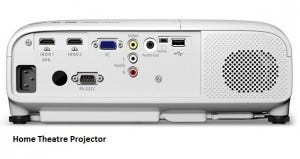With such a wide variety of projectors on the market, it can often be confusing to know what kind will suit your need. Are you looking at something with business or educational presentations in mind, or do you want to create the cinema experience at home. Sometimes you may have the need for both applications. Although you will find that most projectors are adequate for either, it is certain that if you select the projector designed for the purpose, you will be much happier with the result.
Both home theatre and data projectors use similar technology. Each have lamps, lenses, processors and inputs, although it can be the optimisation of the technology within that will lend it more to one purpose or the other. Home Theatre projectors are optimised to display video content and will perform best for moving images rather than static images. Colour control is adjusted to offer the best performance for content such as skin tones, shadows and highlights. A data projector is optimised to display computer data and static images with bright, crisp colour. A data projector is less likely to worry about optimisation of flesh tones.
Input ports may differ between the genres also. Data projectors are more likely to use inputs such as DVI or VGA, which are compatible with computers and laptops. They will often include features such as networking, sometimes wirelessly to show information from a PC. A home theatre projector will likely have a component signal and present a wider range of input options including HDMI, which will lend itself to connect with other home theatre devices such as Blu-ray/DVD players and AV receivers/amplifiers.
A projector which is suitable for home theatre and gaming will be able to display fast moving video smoothly, without delay or ghosting. You may find technology such as “frame interpolation” which is when the projector inserts frames into a movie to make fast moving sequences look as smooth as possible. It will also be able to display in a 16:9 format, whereas a data projector typically displays in a static square 4:3 picture. A home theatre projector will be a larger unit as it has to hold a lot more technology and a large baffle to help cool the projector, which makes the portability of smaller data projectors appealing if you have to carry it to various locations.
The demands of both genres are quite unique. A business or educational presentation will often be in an office environment in a well lit room, whereas movies are enjoyed best in a darkened room. With this in mind, it is easy to understand why the brightness (lumens) levels would be different for each application. To achieve good visual clarity in a brighter environment, data projectors must emit a higher lumen rate. With this in mind, you will find that many of the newer home theatre projectors are now capable of higher lumens levels. This may explain why some choose to adopt a home theatre projector for hybrid purposes.
If you are unsure about which projector will suit you, feel free to call and speak with one of our Selby Techs on 1800 69 2225










